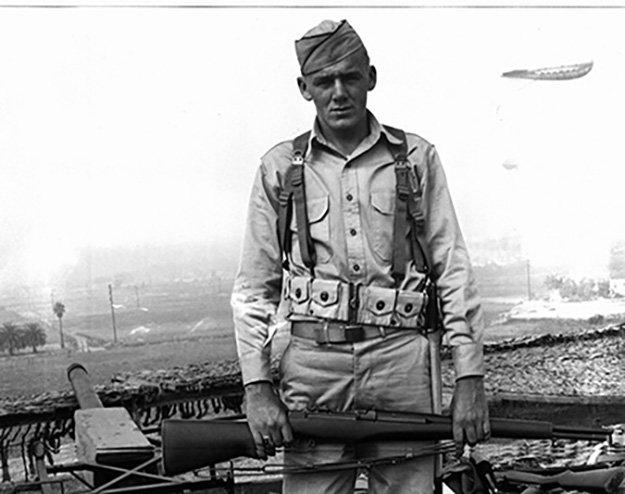CAMP MURRAY - As the sun rose on Dec. 7, 1941, U.S. military personnel stationed at Pearl Harbor Naval Base were starting their Sunday routines. Unknown to them, more than 350 Imperial Japanese bombers, fighter and torpedo planes launched from six aircraft carriers in two waves with their eyes set on the base just outside Honolulu.
A day that will live in infamy, the attack propelled the United States and President Franklin Roosevelt to declare war on Japan and officially enter World War II.
This one event may have been the tipping point, but the U.S. military had already begun preparing for an attack on the mainland. Ten months before the events on Pearl Harbor, two Washington National Guard units, the 205th and 248th Coast Artillery Regiment, had been called into federal service at North Fort Lewis to begin training on a highly important mission that would span the course of World War II and beyond.
The 205th Coast Artillery Regiment (Anti-Aircraft)
The 205th Coast Artillery Regiment (Anti-Aircraft) and 248th Coast Artillery Regiment (Harbor Defense) were called into service Feb. 3, 1941, to train on what would be a four-year mission of protecting the West Coast and Los Angeles, San Francisco, Portland and Seattle.
In June 1941, the units began mobilizing across the West Coast and parts of Alaska. Battery E, 205th Coast Artillery, set sail from Seattle for Seward, Alaska. In July, two additional batteries of the 205th joined them as part of the defense of the Northwest Passage, a waterway connecting the Pacific and Atlantic oceans near the Arctic Circle.
On Oct. 29, 1941, the War Department directed the remaining units of the 205th Coast Artillery to move to Camp Haan, near Los Angeles. The unit arrived for duty Nov. 22, 1941, only two weeks before the attack on Pearl Harbor.
After more than two years of service in Southern California, the 205th went through a number of reorganizations. Some units split off and were assigned to other commands. One such unit was the 530th Anti-Aircraft Artillery Weapons Battalion (AAAW BN) (originally 2nd Battalion, 205th Coast Artillery), which mobilized to Greenock, Scotland, in December 1944. The 530th AAAW BN was reassigned to the 15th Army and moved to Germany in April 1945 before returning to New York City for deactivation on Halloween 1945.
Battle of Los Angeles
On the night of Feb. 24, 1942, just three months after the attack on Pearl Harbor, air raid sirens sounded throughout Los Angeles County, signifying an attack was imminent. A blackout was ordered, and thousands of air raid wardens were summoned to their positions.
Washington National Guardsmen from the 205th Coast Artillery assigned to the 37th Coast Artillery Brigade took their positions in the dark, preparing to defend their country from another attack.
Then at 3:17 a.m., the Guardsmen began firing their 50-caliber machine guns and 12.8-pound anti-aircraft shells into the air at reported aircraft. More than 1,400 shells were launched in the next hour. When the "all-clear" was given at 7:21 a.m., several buildings and vehicles had been damaged by shell fragments.
Within hours of the end of the air raid, Secretary of the Navy Frank Knox held a news conference, saying the entire incident was a false alarm due to anxiety and "war nerves." A statement by the Army the following day claimed the incident might have been caused by commercial airplanes used as a psychological warfare campaign to generate panic.
Speculation was rampant about invading airplanes and their bases. Theories included a secret base in northern Mexico and Japanese submarines stationed offshore with the capability of carrying planes. Others speculated the incident was staged or exaggerated to give coastal defense industries an excuse to move further inland.
In 1983, the Office of Air Force History concluded meteorological balloons caused the initial alarm.
The 248th Coast Artillery Regiment (Harbor Defense)
The 248th Coast Artillery Regiment (Harbor Defense) was called into active federal service by presidential proclamation Aug. 31, 1940.
One of the original field artillery units of the 2nd Infantry, Washington National Guard Regiments, the 248th was used to federal activations. Organized into 12 companies of coast artillery, the 248th was ordered into federal service by the president on July 25, 1917, and assigned to duty at the harbor defenses of Puget Sound.
As coastal artillery become more important after World War I, the 248th added three more companies in Aberdeen, Snohomish and Olympia. With the addition of the 205th Coast Artillery Regiment in 1939, Washington had two units focused on the defense of the coastlines against enemy aircraft.
On Sept. 1, 1940, the 248th Coast Artillery was organized by combining the 1st Battalion and Regimental Headquarters Battery, 248th Coast Artillery. On Sept. 16, 1940, the 248th Coast Artillery (HD) was inducted into federal service at the home station of the respective batteries and concentrated at Fort Worden, Washington. The entire 248th Coast Artillery was relieved of harbor defense duties and transferred to Camp Barkeley, Texas, leaving Fort Worden, on April 25, 1944.





Read Comments